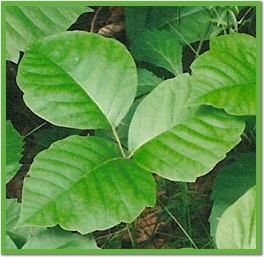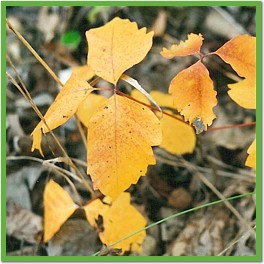
Poison Ivy! Look, but don't touch. |
By Johnny Caryopsis |

Everyone should learn to recognize
the waxy green leaves of Poison Ivy.
I take great pride in knowing the names, as well as a little something about, nearly all the plants that I encounter in Manitoba. In fact, I can't seem to shut my brain off when I'm out in natural areas; it's constantly identifying and cataloguing the plants I see wherever I go. This gets to be a drag some times. I'd like to just go for a walk and enjoy the scenery. But the brain is looking for botanical diversity and rattling off plant names as I go: "Andropogon gerardii, Bouteloua curtipendula, Liatris ligulistylis", and so on. And, of course, I forget that not everyone shares my expertise, or my enthusiasm, for native flora. So, I can be a pain in the butt to go for a walk with, correcting people that make incorrect declarations of plant species along the way. But I've also saved a few people from some nasty encounters, too. And if you're looking for a good reason why anyone should care about floral diversity and being able to identify individual plant species, then I have two words for you: Poison Ivy! Keeping yourself and others out of it, and away from some other of Manitoba's nasty plants, is reason enough to take a course in plant identification.
Poison Ivy . . . sure, everyone's heard of it, and most have heard that insipid little rhyme: "leaves of three, let it be", but how many of you could reliably recognize Poison Ivy in all its forms and stages? Not many, I'd guess. As a case in point, let me relay a recent conversation with my brother-in-law.
My sister's family is building a cottage north of Victoria beach along Lake Winnipeg's east shore. My family went up for a visit one day in June and my brother-in-law and I took the dogs, his and mine, for a walk with the kids. The kids and dogs were soon out of sight and my attention, of course, turned to the flora along the trail where we were walking. "Hmm, fair bit of Poison Ivy around here", I grunted. Actually, I was being a little facetious, there was tons of it around.
"Yeah, that's what I've heard, but ya know, I really don't know what it looks like", he replied.
I couldn't resist. "Look down", I said, "you're surrounded by it." The entire forest under story and all along the edge of the trail was Poison Ivy and very little else.
"What . . . this stuff?" was his response.

Poison Ivy isn't always green.
"Yeah, about 90% of the ground cover around us right now is Poison Ivy."
"Ooh, guess we better be careful then."
"That would be prudent", I suggested.
Now, my brother-in-law is a smart guy, and has even spent his fair share of time in the bush, but he's like most Manitobans and has limited knowledge of the diversity of plant life in this province, or how to go about identifying individual plants. So I gave him a crash course, at least as far as Poison Ivy goes. And the whole episode got me thinking. Not just about how Poison Ivy would be a good idea for a NatureNorth article, but also about getting people to really focus on identifying one particular plant; one which they have a vested interest in knowing and avoiding. Perhaps the process might intrigue them and they'll pursue it more, and learn more about identifying our native flora. And that can't be bad.
So, as you follow through this article, I hope you'll pay special attention to the details of the plant descriptions I present; those of Poison Ivy and it's look-a-likes. At the least, I hope it will keep you from some irritating encounters. At best, perhaps it will inspire you to take a closer look at more of Manitoba's wild plants.
Carry on for More about Poison Ivy![]()
| You can help NatureNorth produce more great articles with a secure donation through PayPal. Our Google Adsense ads pay our server costs, but that's about it. To learn more follow this link: Support NatureNorth. Thank-you! | |
Return to: Summer Issue | NatureNorth Front page
